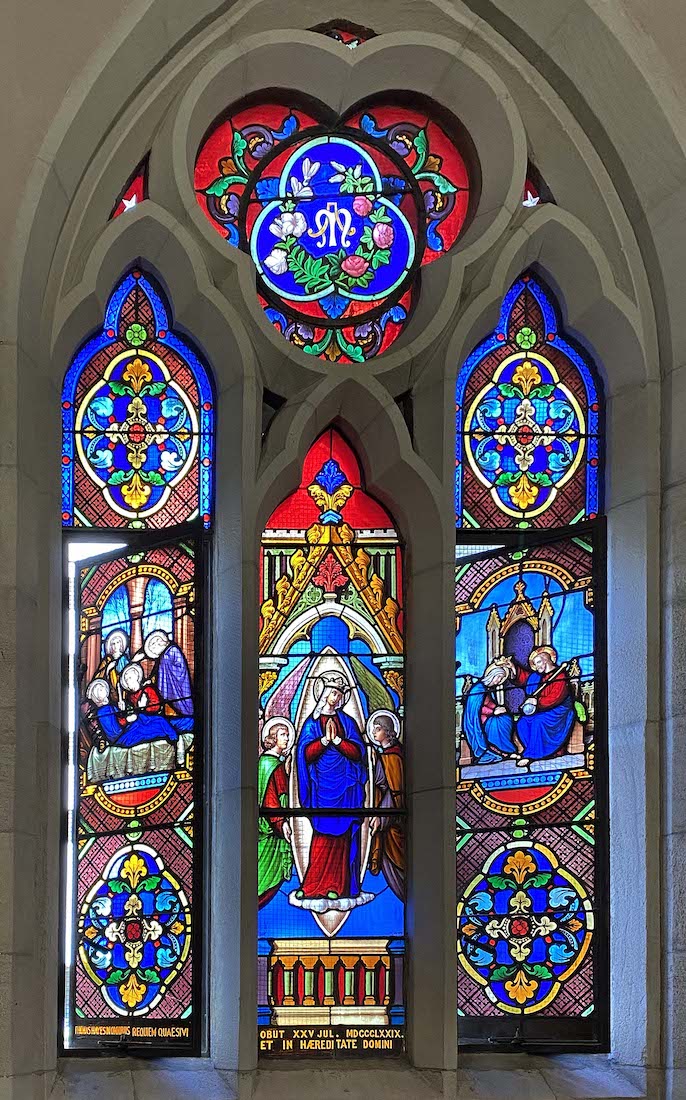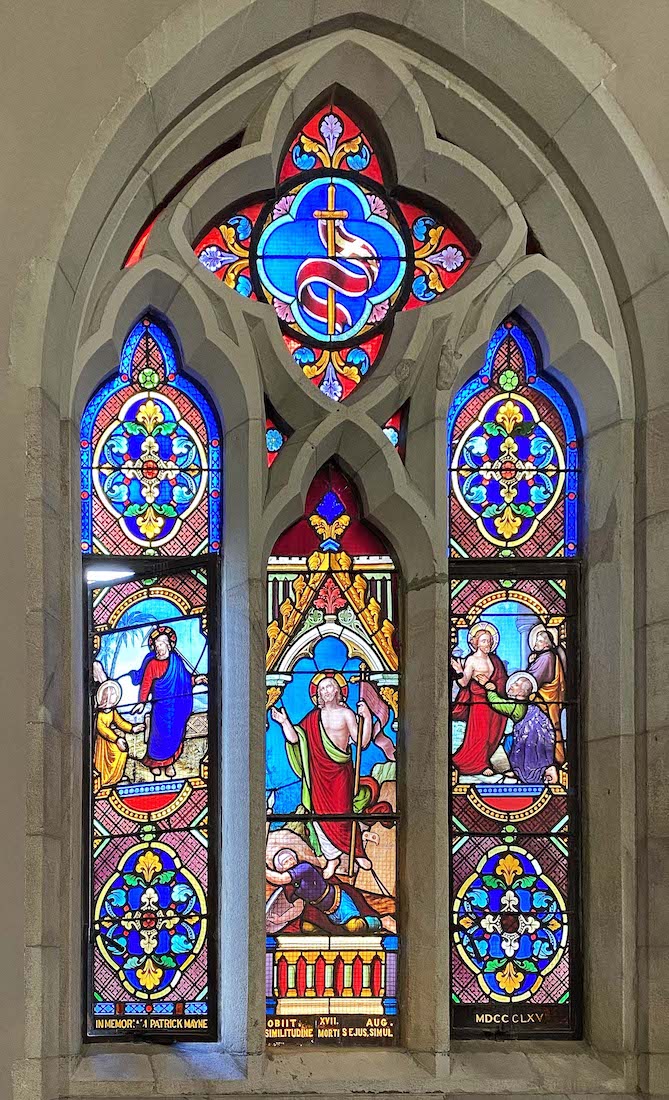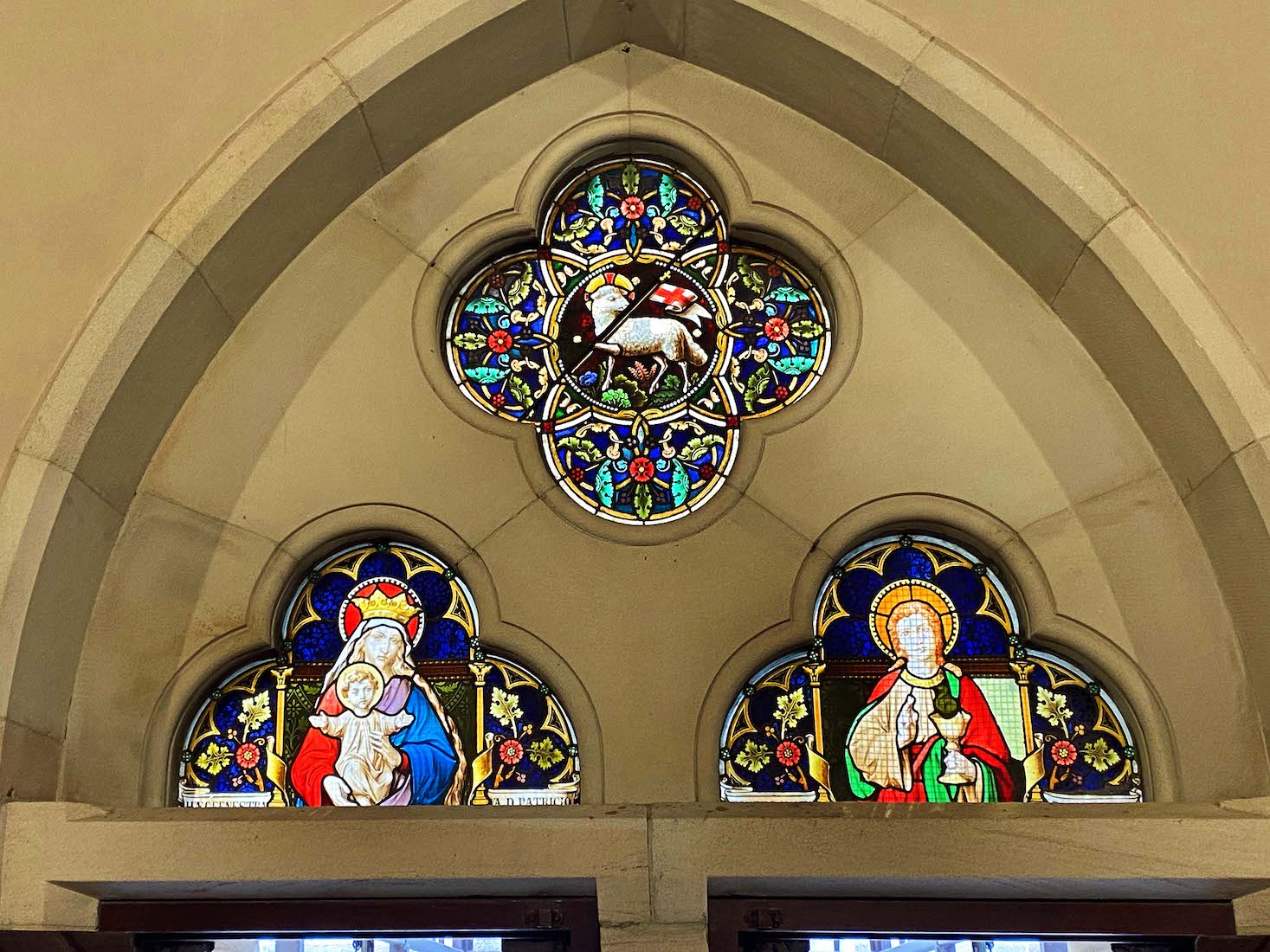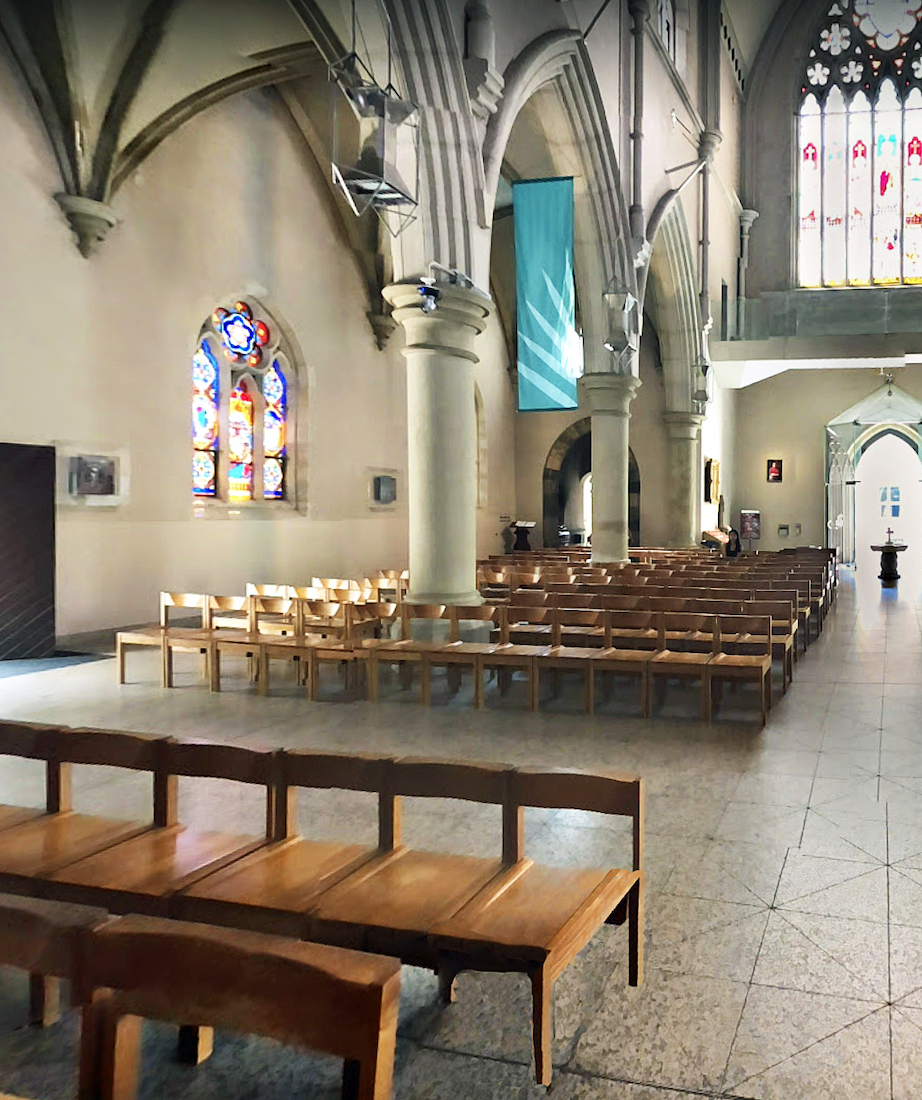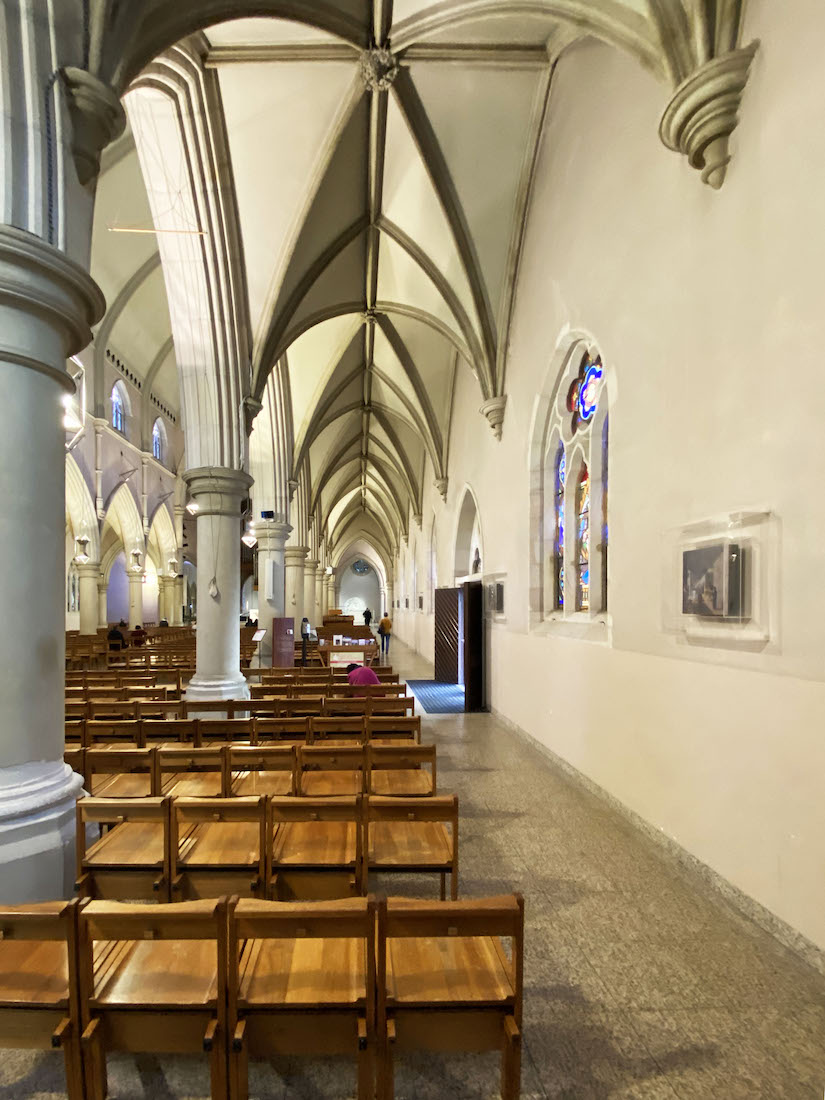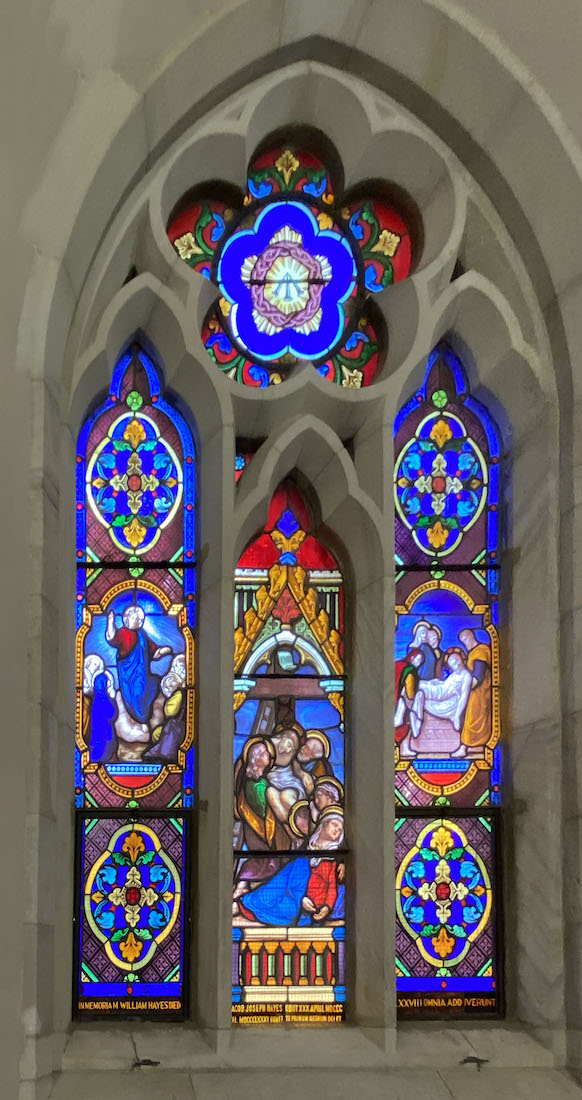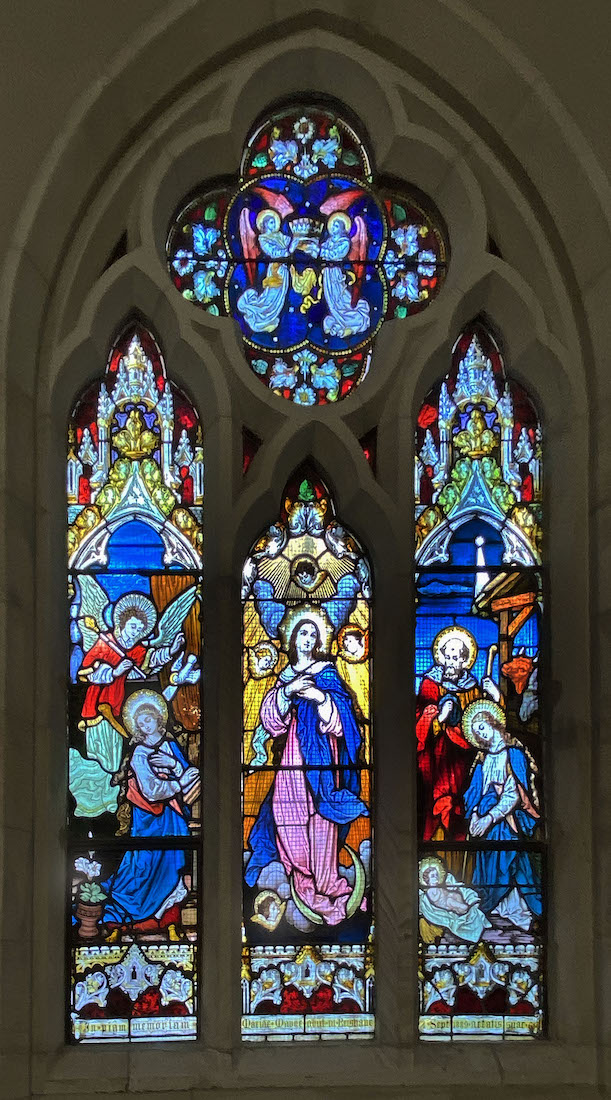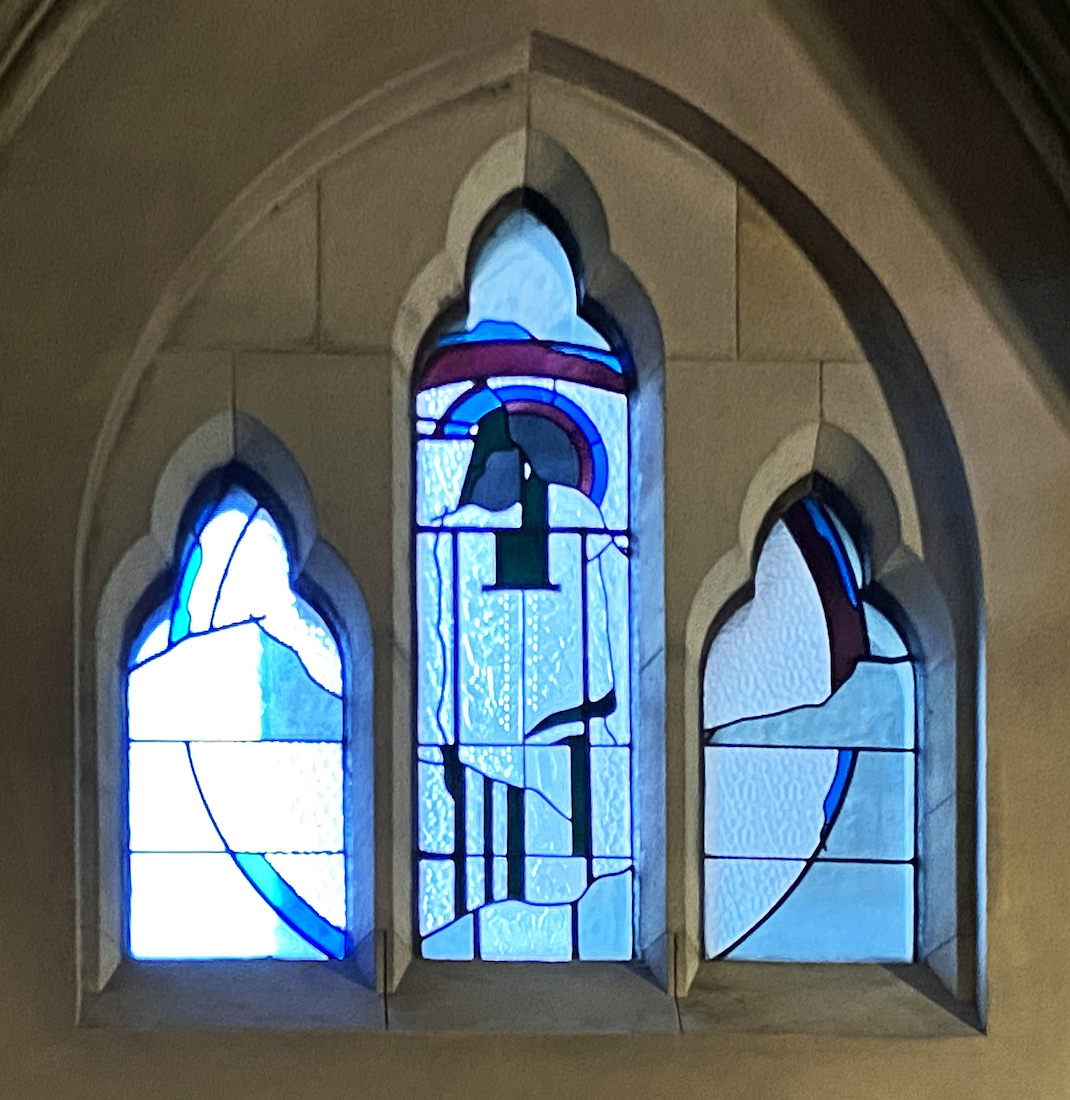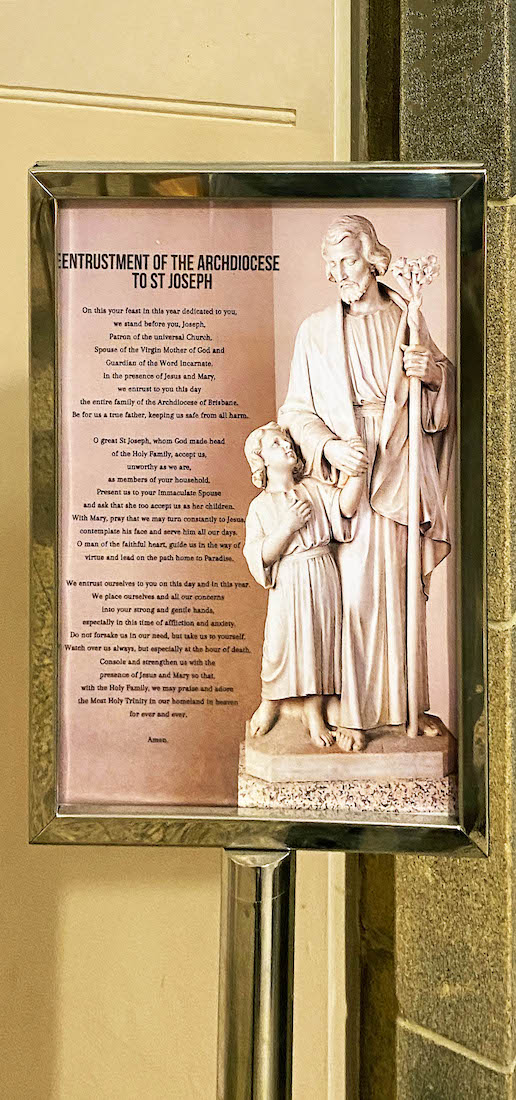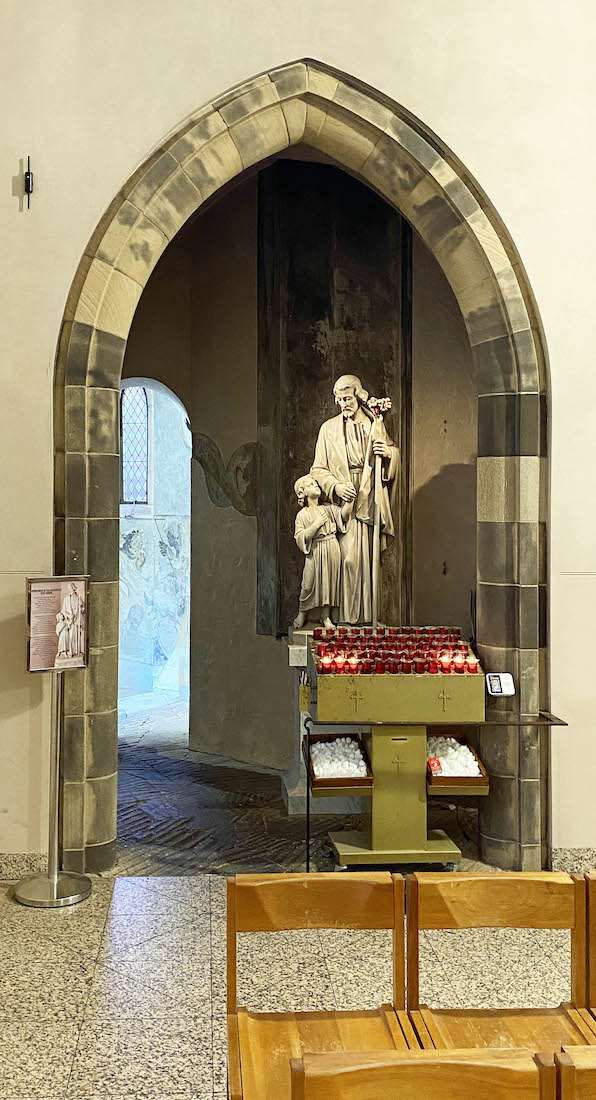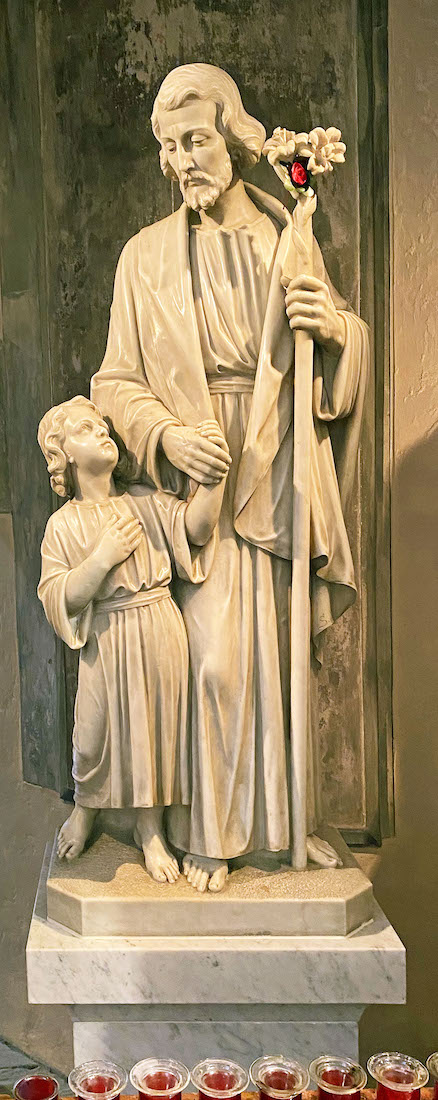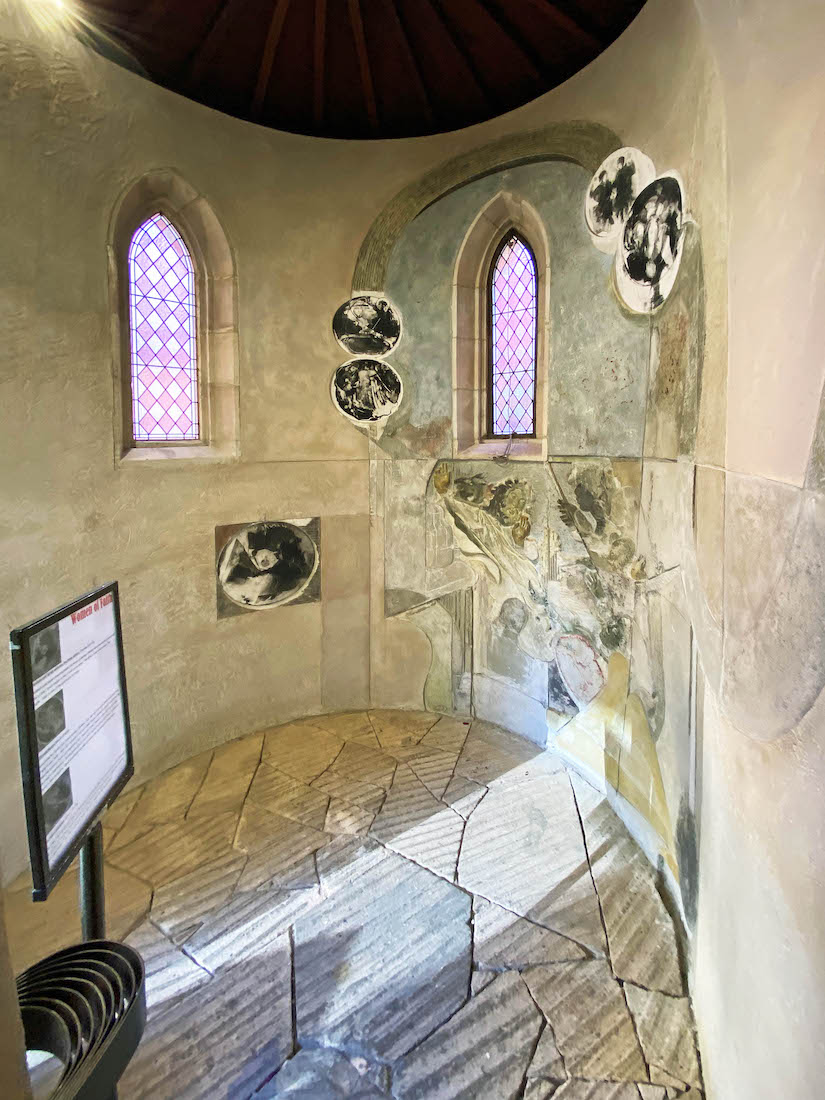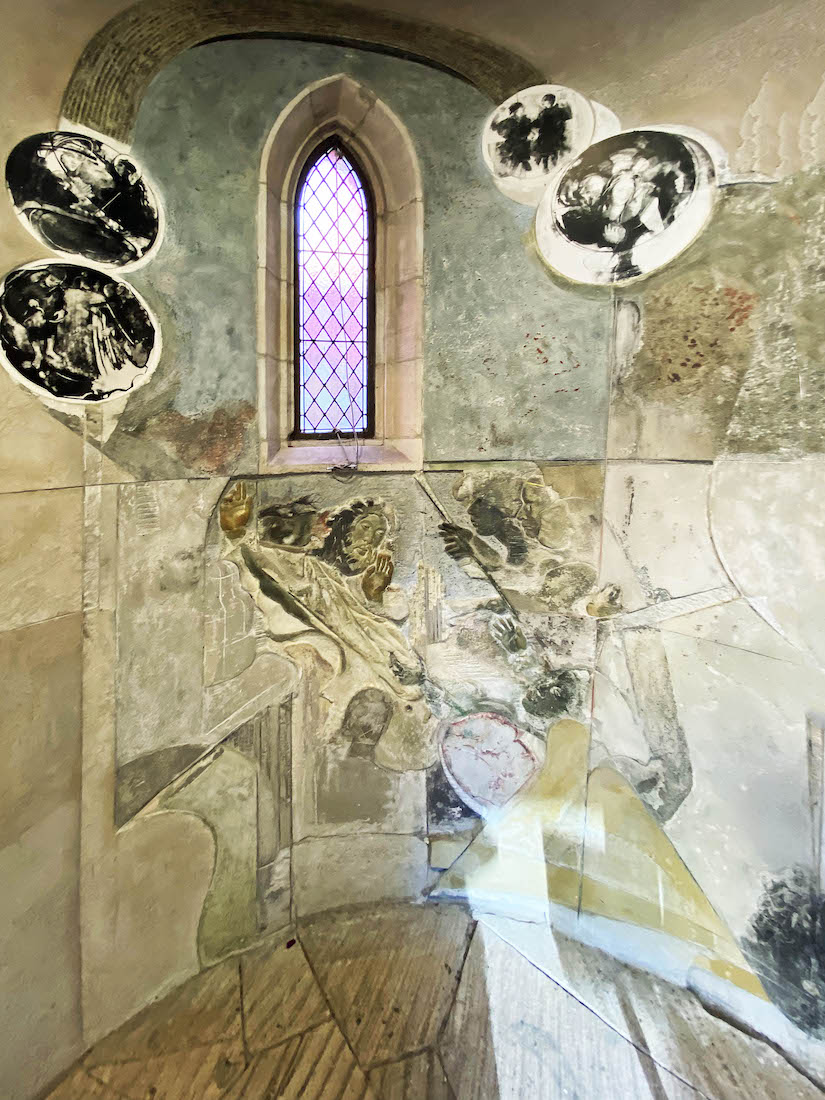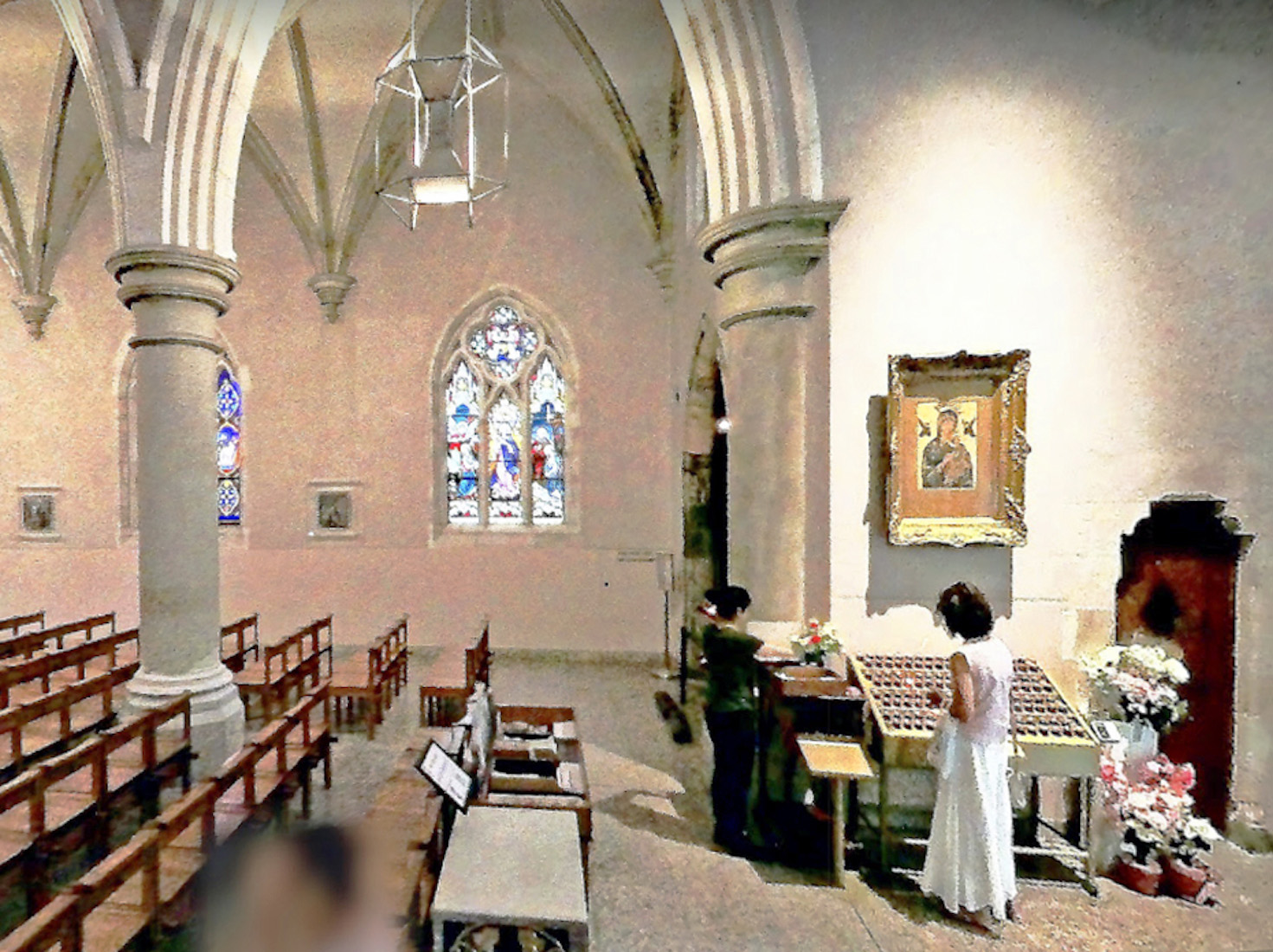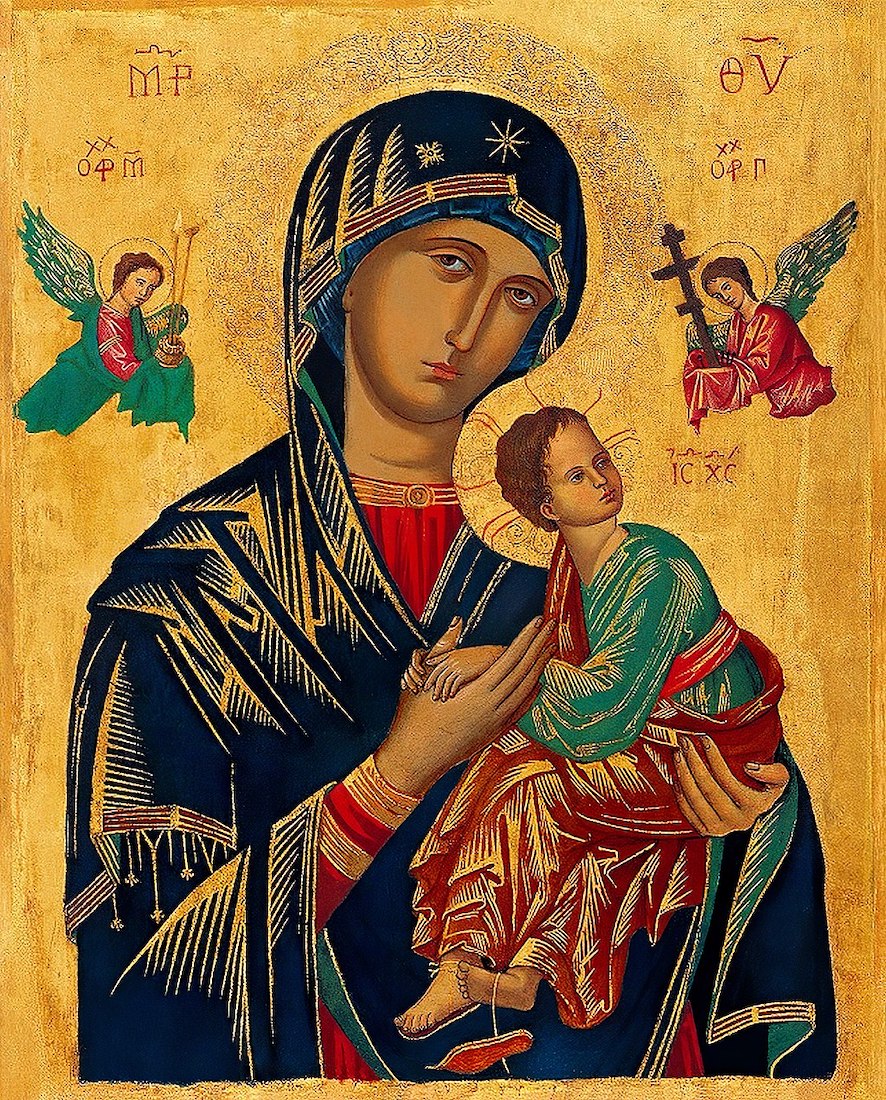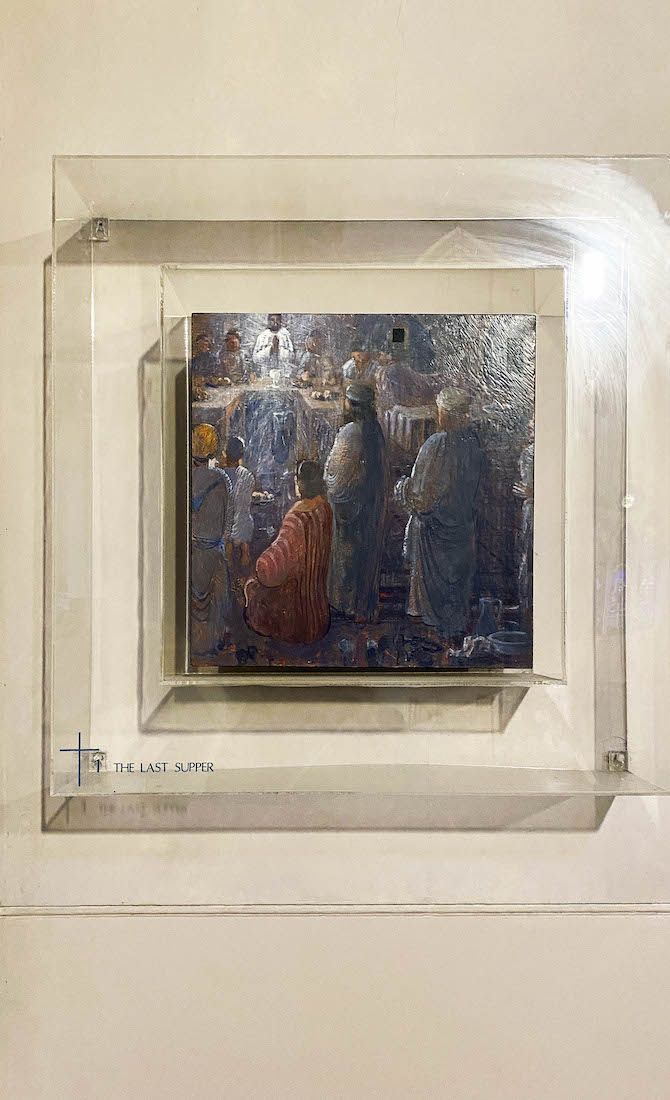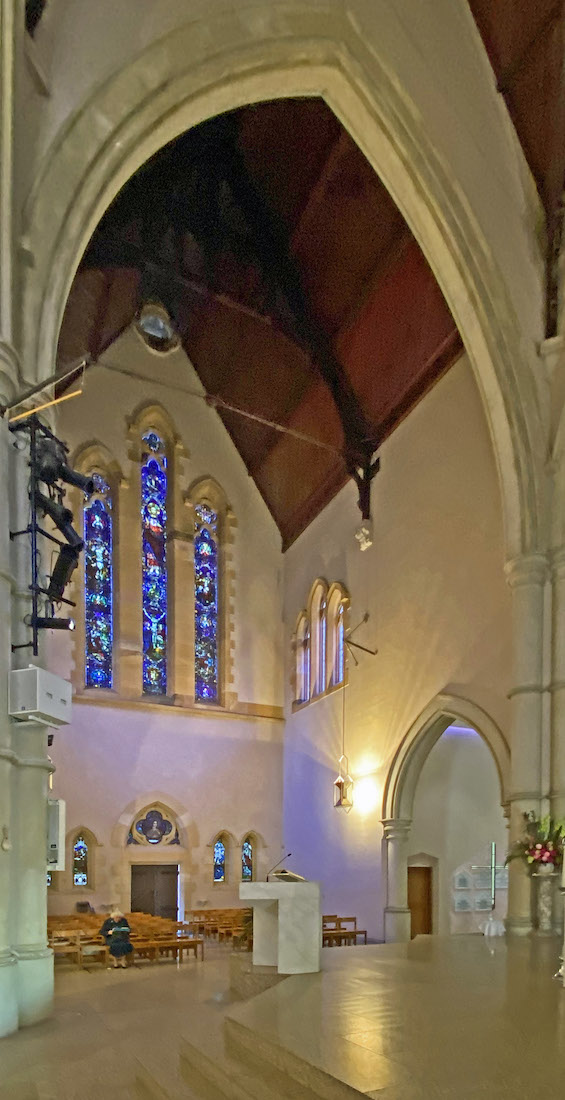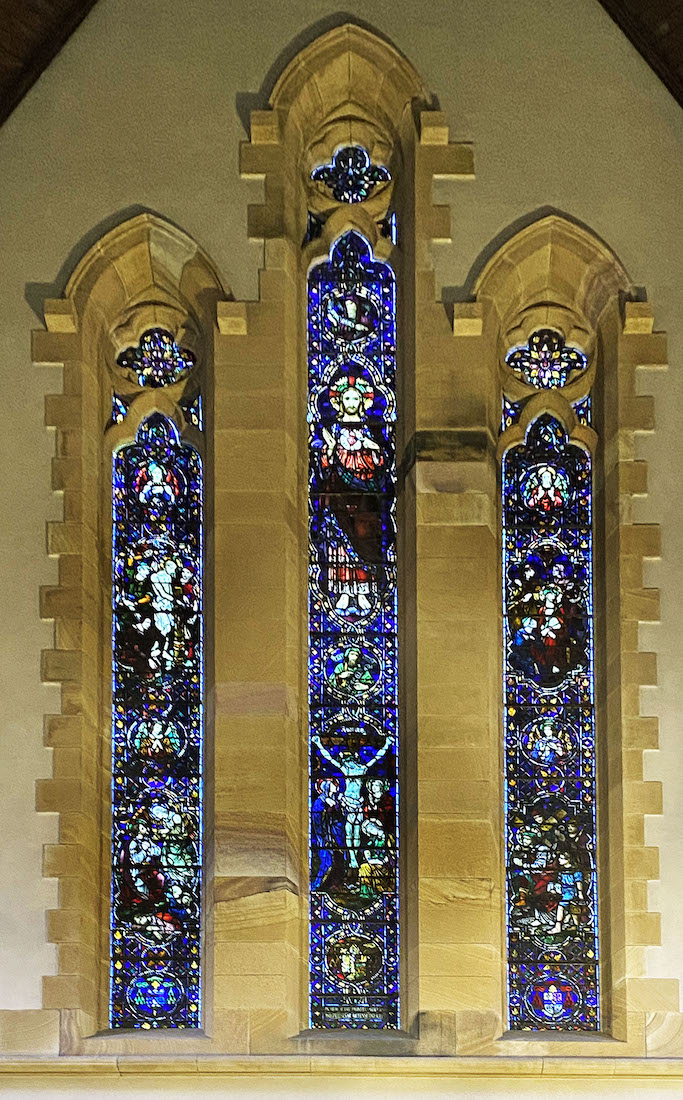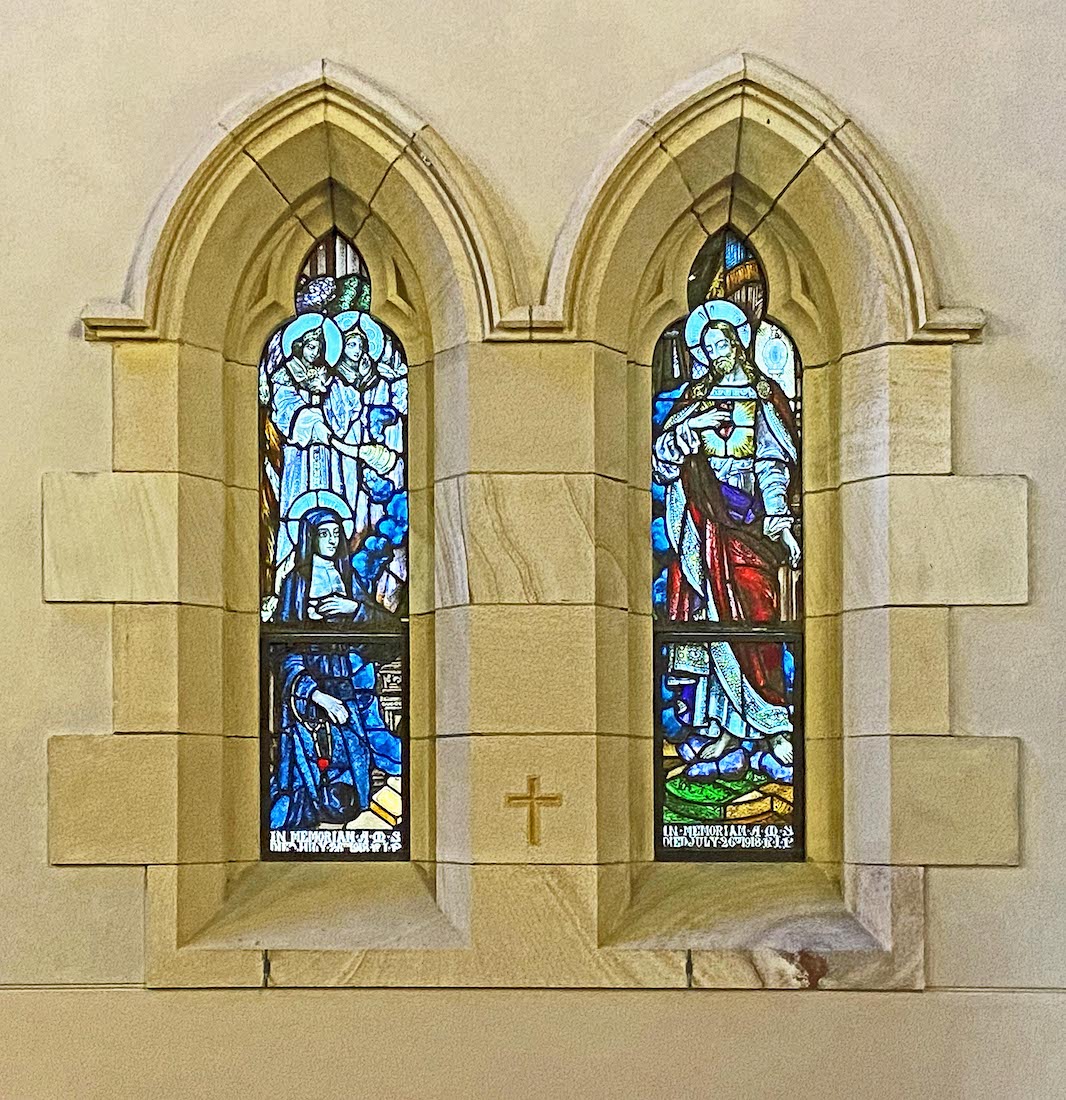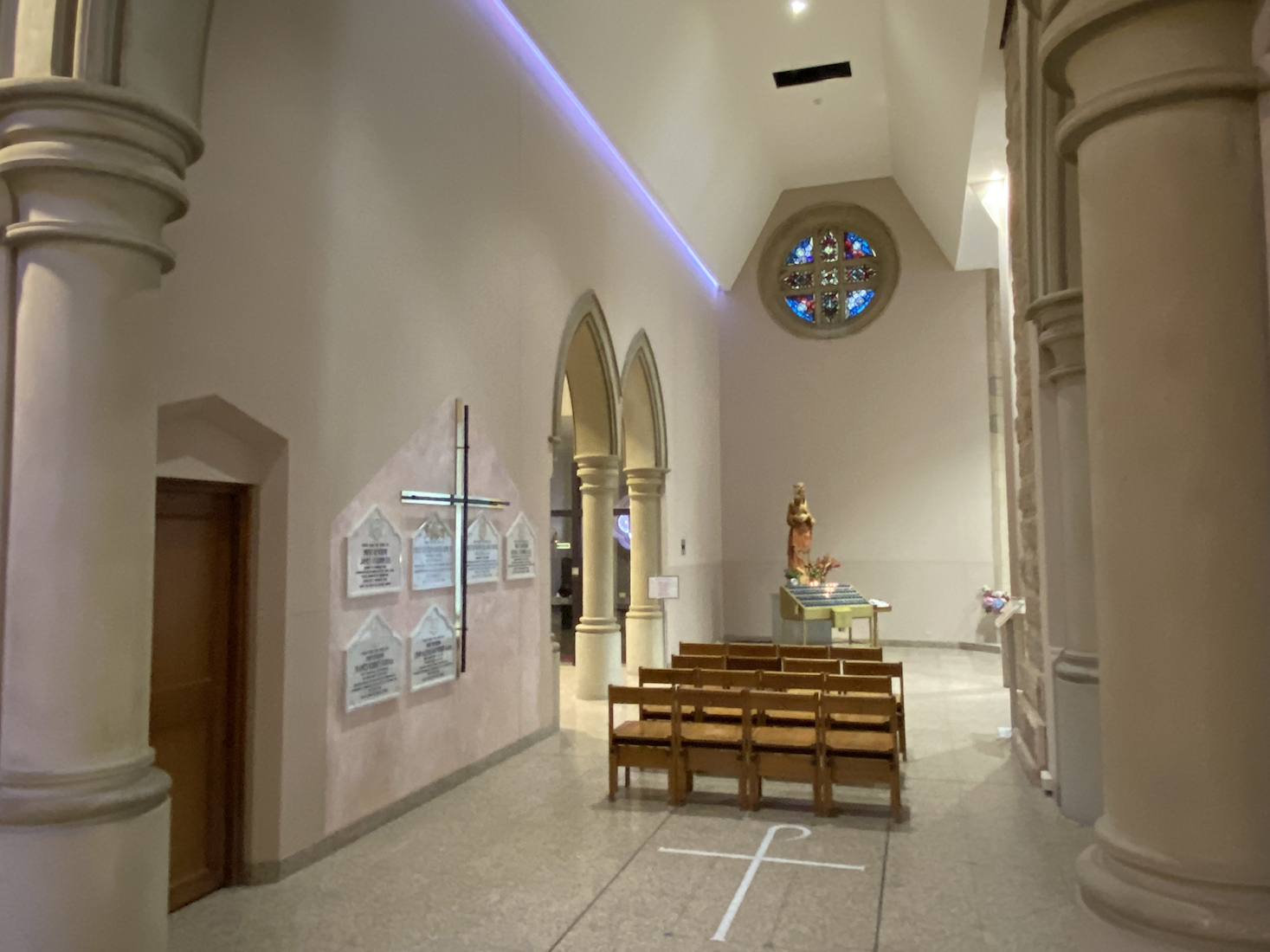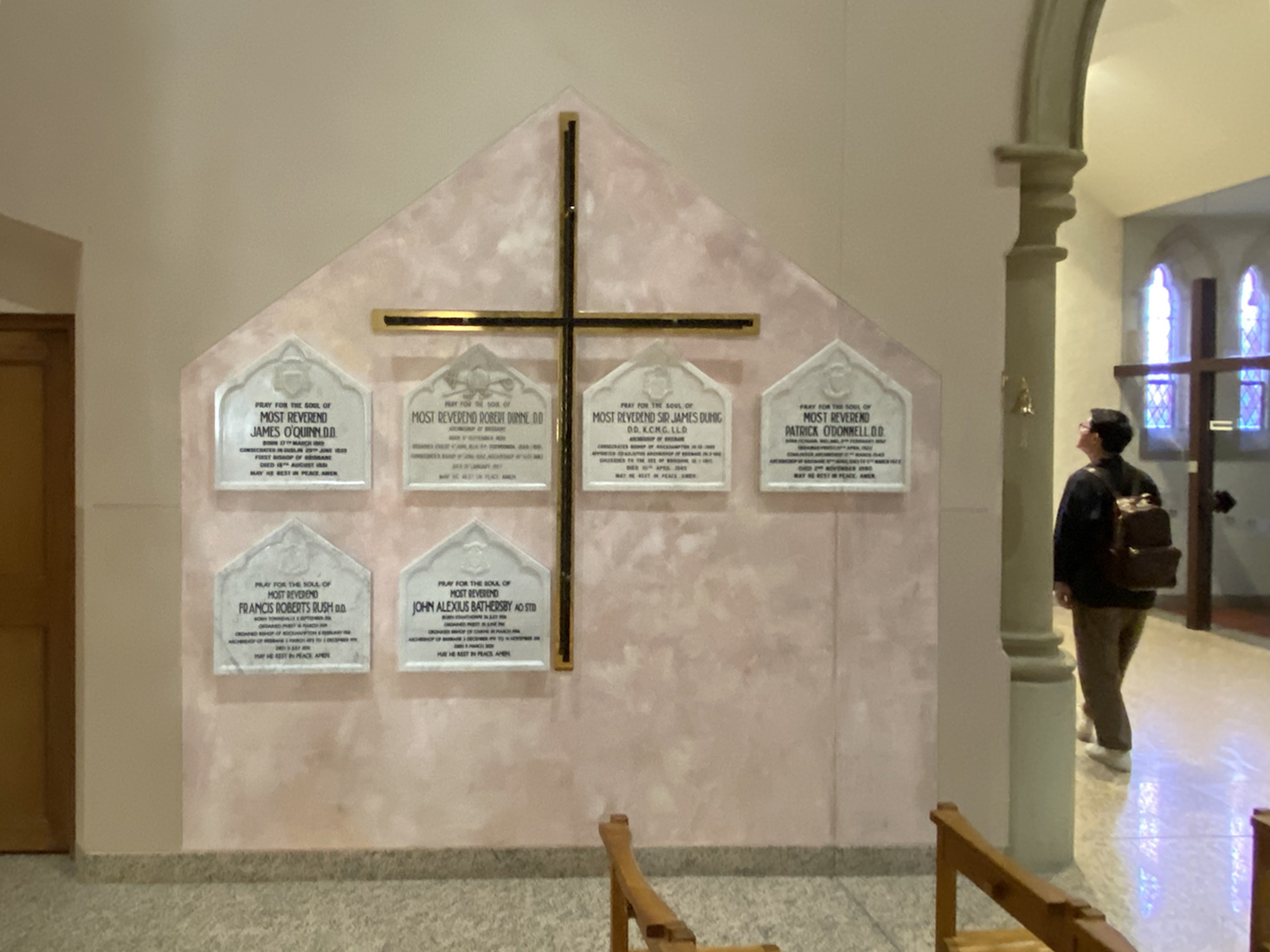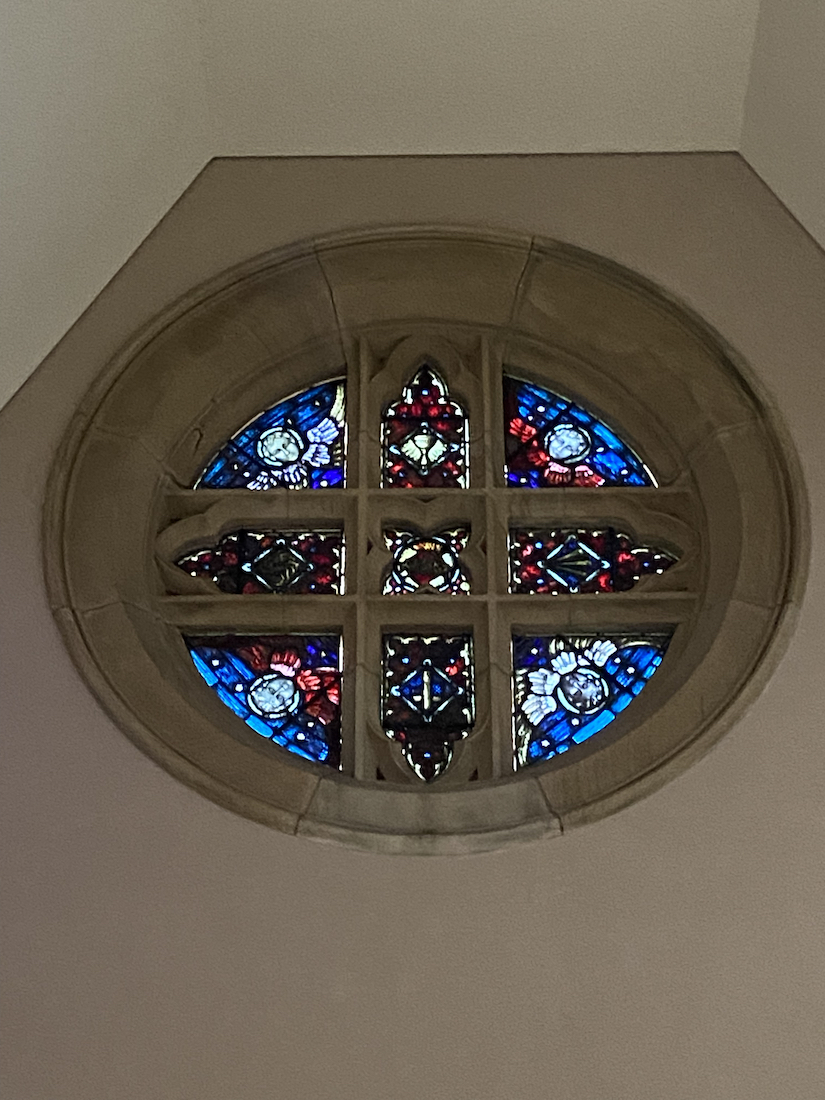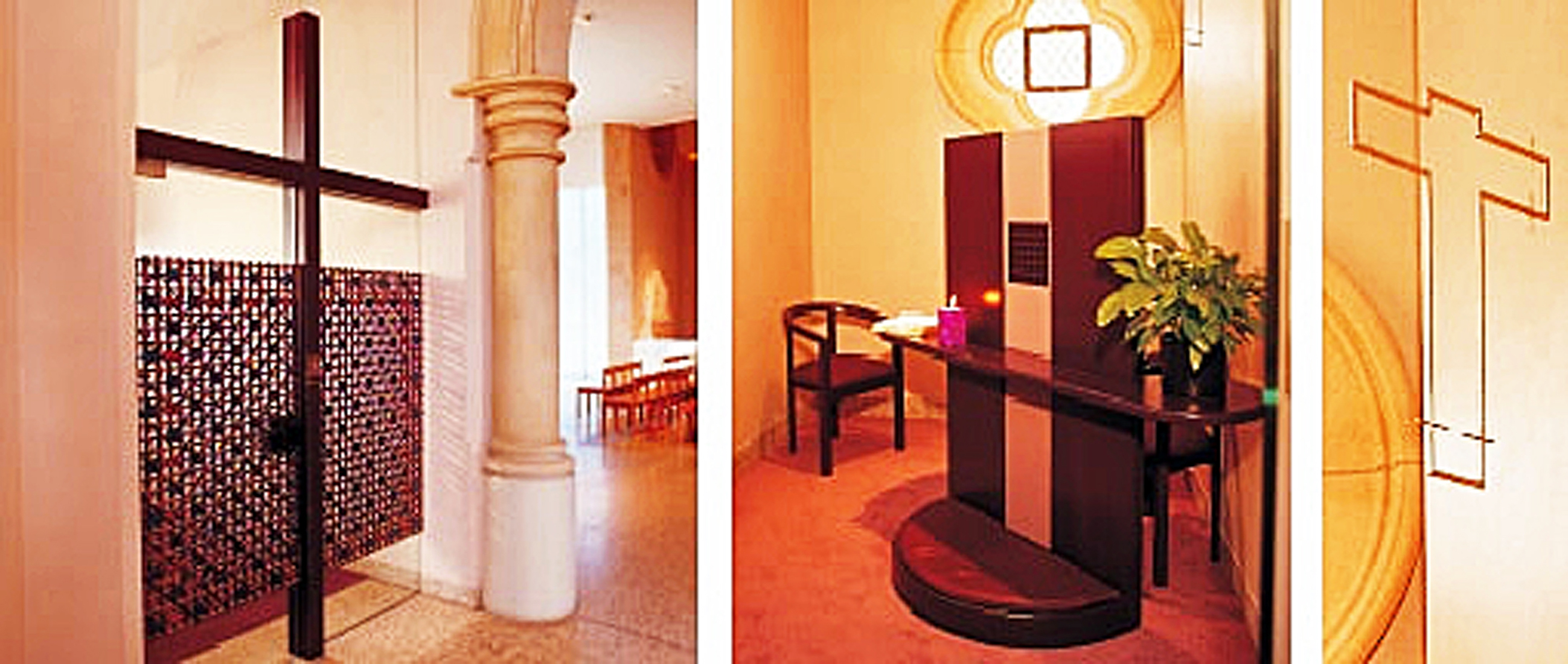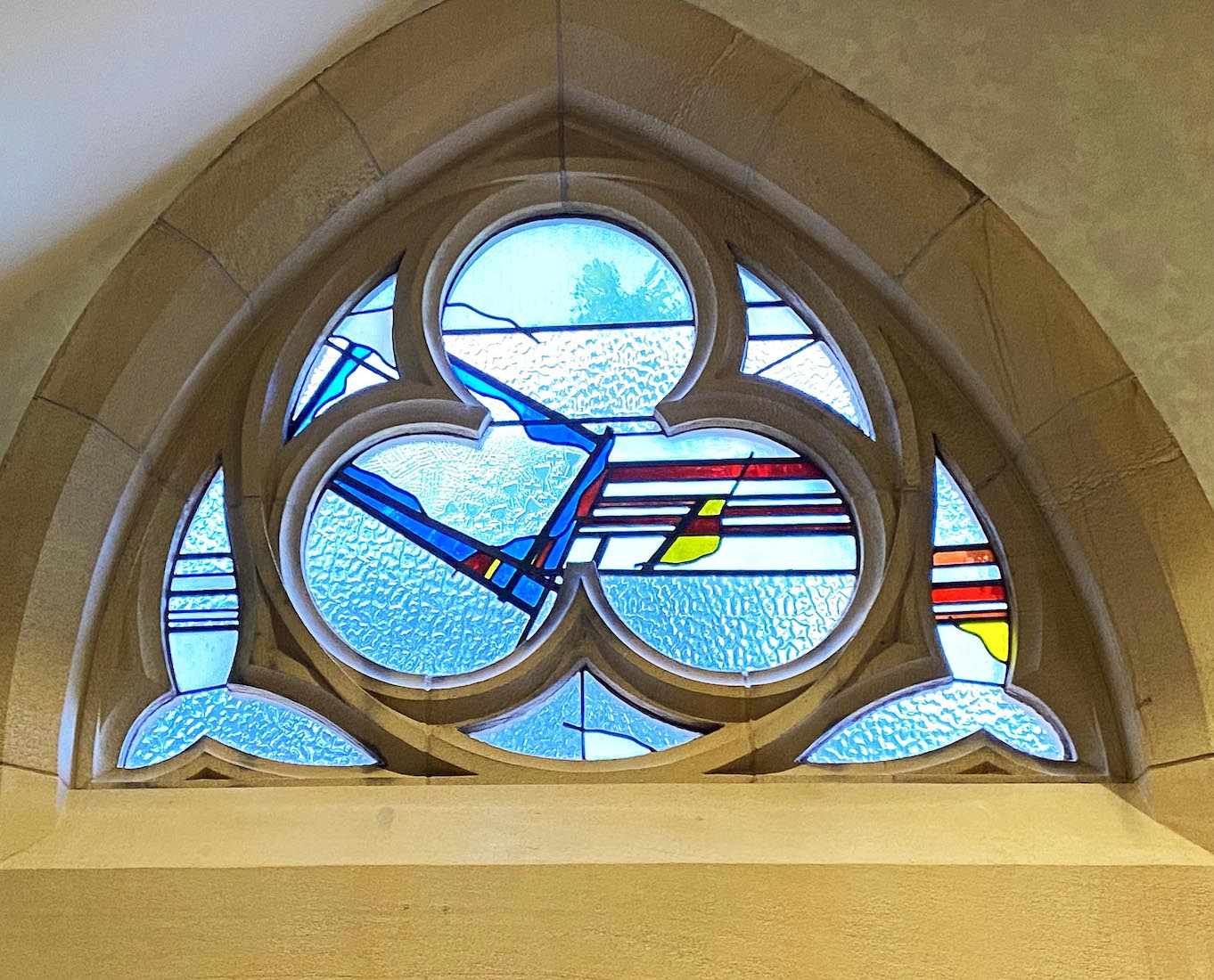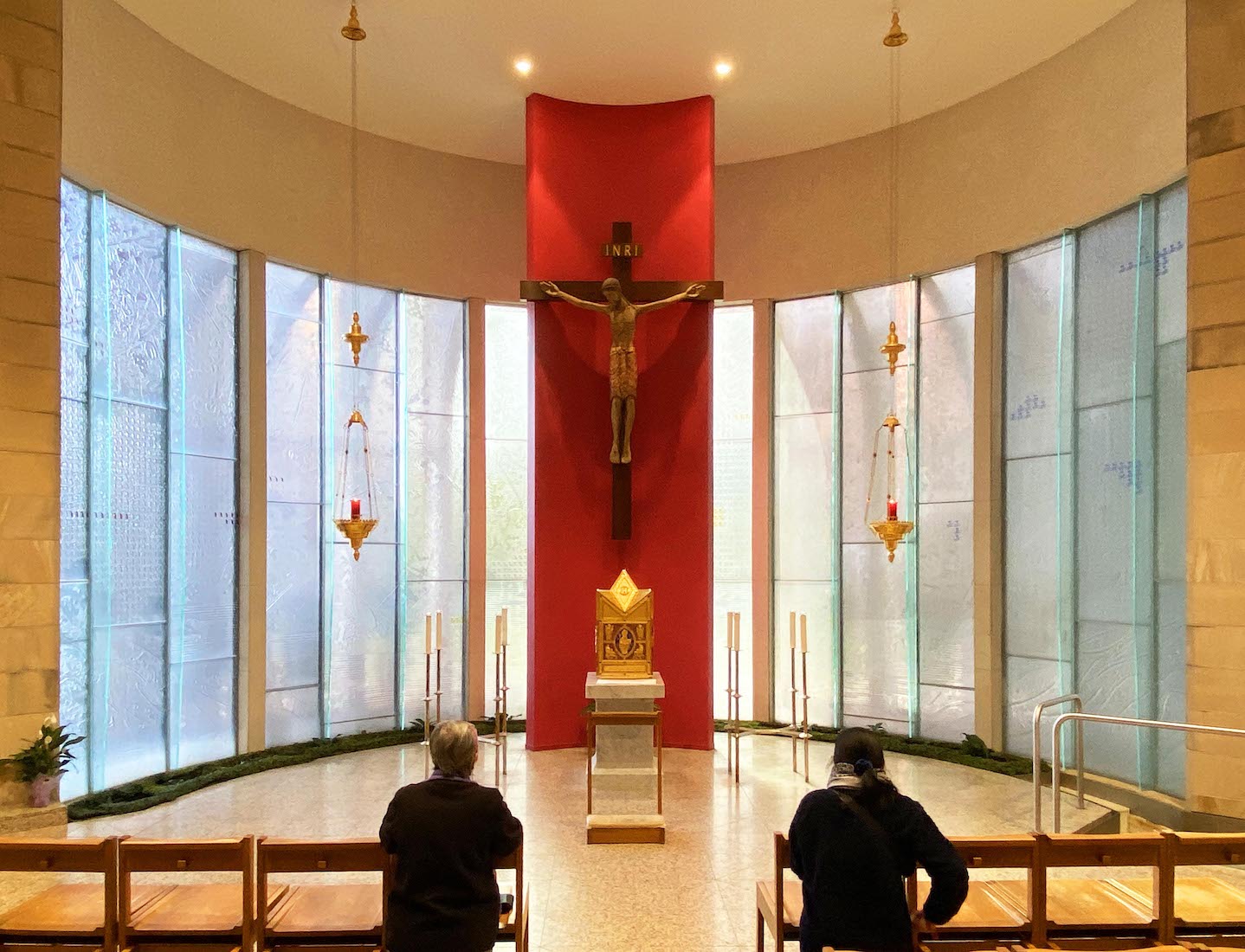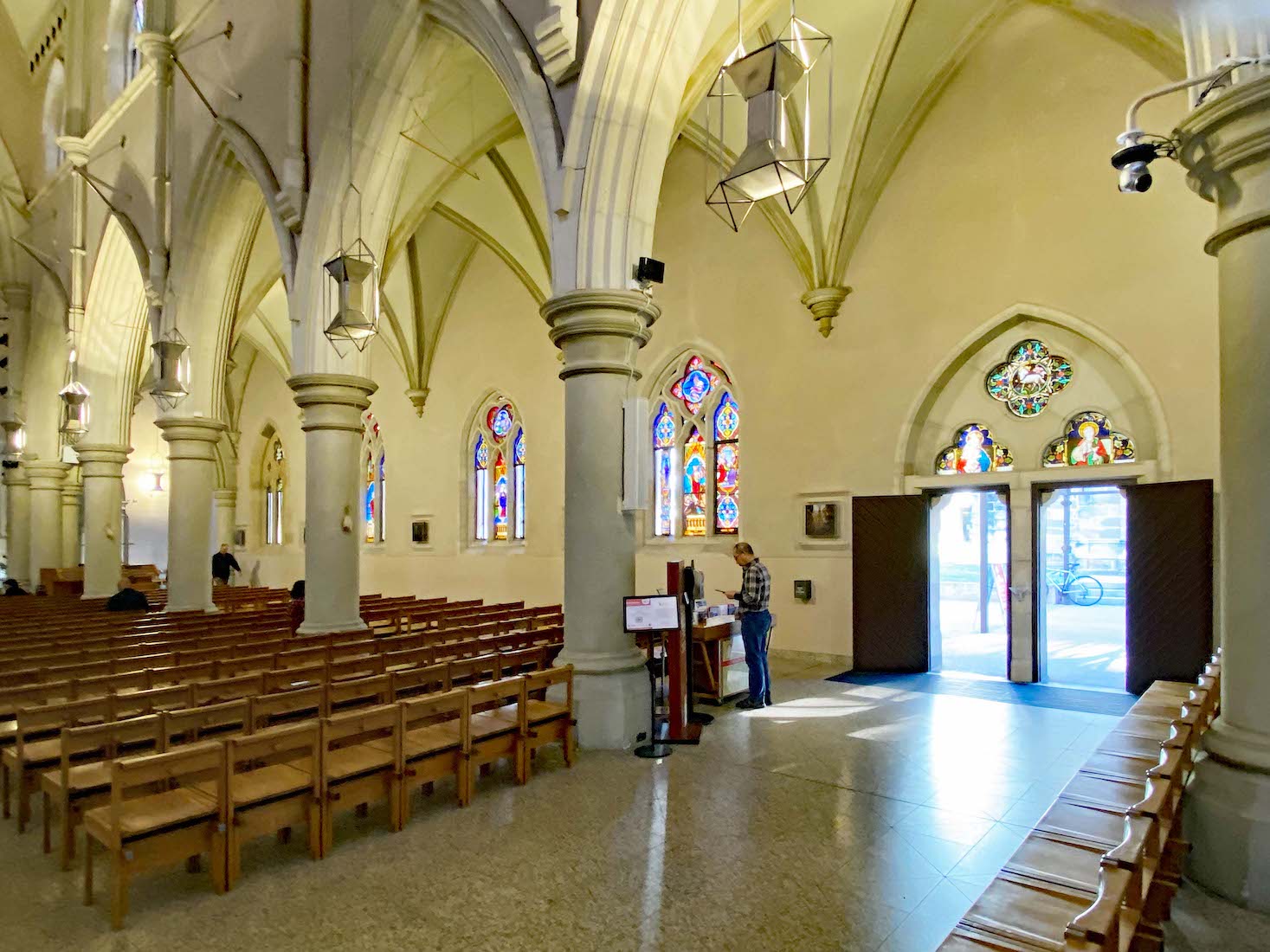
We cross the nave to look at the windows of the South wall, starting from the Eastern end. INDEX
42. SOUTH NAVE WINDOWS I
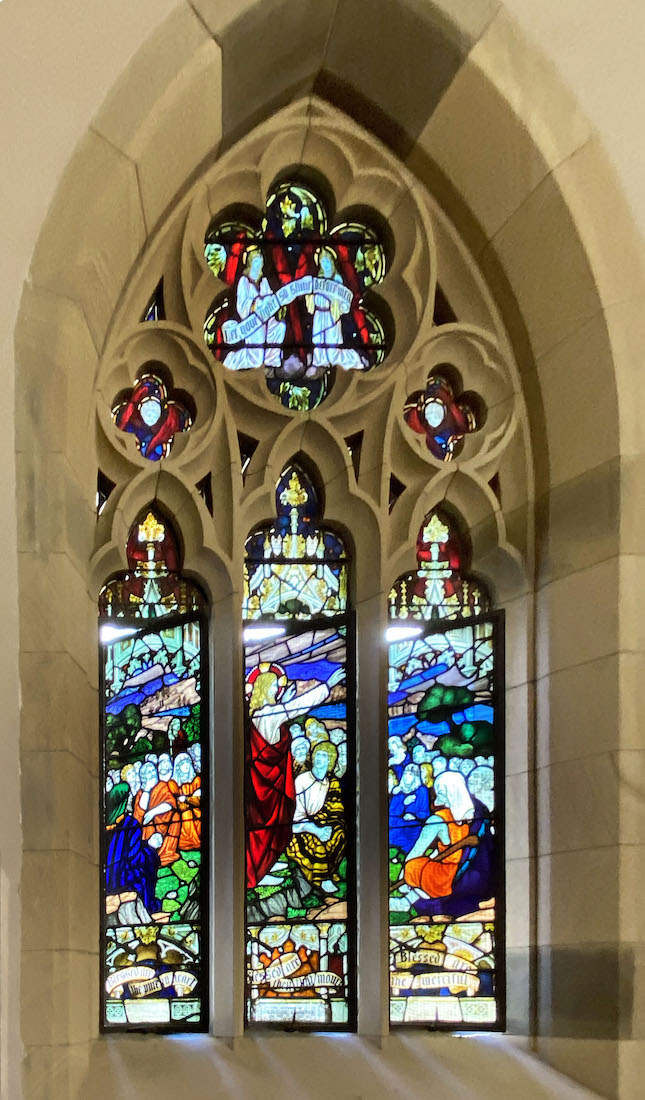

The first window (at left) shows Jesus preaching to the crowds. It is the Sermon on the Mount, with Jesus telling people about the Beatitudes. ••• The window at right shows scenes from the life of Mary with the Annunciation (the angel Gabriel speaking to Mary) at left, the Visitation (Mary’s visit to Elizabeth) at right, and a picture of Mary overcoming the serpent at centre.
43. SOUTH NAVE WINDOWS II
The left window shows scenes at the end of Mary’s life: her death, assumption and coronation. The window at right shows scenes near the end of Christ’s earthly life: his Resurrection, appearing to Mary, and encounter with Thomas.
44. ABOVE THE SOUTH NAVE DOOR
These wonderful windows sit above the South nave door. The Cathedral windows include outstanding examples of the art of stained glass coming from France, Germany, Ireland, England and Australia and make up one of the finest collections of 19th century stained glass in Australia. Most of the glass in the nave is from the 1880s. ••• The top window here shows the Agnus Dei – the Lamb of God – curiously carrying an English banner. The bottom medallions show the Virgin and the Child, and St John the Evangelist. All these panels came from the Zettler Institute.
45. SOUTHWEST NAVE
We check out the South aisle West of the South door. There are two more stained glass windows in the South wall.
46. SOUTH NAVE WINDOWS III
The left window depicts the final scenes in Christ’s earthly life, with His body being taken down from the Cross and placed in a tomb, and then the Resurrection. ••• The right window is all about Mary: the Annunciation, the Nativity, and her Glorification.
47. HIGH WEST WINDOW
At the West end of the South aisle there is a high window – again modern and minimalist. Its meaning eludes me!
48. JOSEPH WITH JESUS
In the Southwest corner of the Cathedral and below the high window is another small chapel. At its entry stands a sculpture of Joseph holding the hand of a small Jesus. The flowering staff is a recognized definition of Joseph, arising from an old legend. At left is a very nice tribute.
50. LADY OF PERPETUAL HELP
Back to the West entrance where there is a copy of the famous ‘Lady of Perpetual Help’ hanging. Our Mother of Perpetual Succour (colloquially known as Our Lady of Perpetual Help) is a Roman Catholic title of the Blessed Virgin Mary associated with a fifteenth—century Byzantine icon and a reputed Marian apparition. The image has been enshrined in the Church of San Matteo in Via Merulana since 1499, and is today permanently enshrined in the Church of Saint Alphonse of Liguori, where the official Novena to Our Mother of Perpetual Help text is prayed weekly.
51. STATIONS OF THE CROSS
Around the walls of the nave are displayed the Stations of the Cross. These stations were painted by celebrated Australian artist, Lawrence Daws. Their relatively small scale gives them an intimacy which leads to personal contemplation. In planning the paintings, Daws undertook a meticulous study of the life and geography of Jerusalem at the time of Jesus. Each painting is carefully constructed to invite the viewer to step into the deep space created in the picture and to read there the meaning of the event. The gestures, the figures and the objects speak of suffering, redemption and triumph, of injustice and liberation, of conflict, love and compassion. You can view all the Cathedral’s Stations of the Cross here.
53. NORTH TRANSEPT WINDOW
The main window of the North transept has three lancets concentrating on the end of Christ’s earthly life. They include scenes of Christ in the Garden of Gethsemane, Christ carrying his cross, the Crucifixion, and the Glorified Christ (as the Sacred Heart).
54. NORTH TRANSEPT LANCET WINDOWS
Now the lancets on either side of the North transept door ... . At left, St Philomena and St Anthony of Padua. Philomena was a young virgin martyr whose remains were discovered in 1802 in the Catacombs of Priscilla. She is often pictured carrying an anchor. St Anthony of Padua is often pictured with the Christ Child: a legend relates that the Christ Child appeared to an elderly St Anthony. ••• The windows at right show Jesus appearing to Margaret Mary Alacoque, revealing to her His sacred heart – now a well known Catholic devotion.
55. ABOVE THE NORTH TRANSEPT DOOR
Above the North transept door is this window depicting St Thérèse of Lisieux. The window is the work of Harry Clarke of Dublin. It depicts St Thérèse, the ‘little flower’, a 19th century Carmelite nun. She died at the age of 24 and was canonized in 1925, the same year this window was donated by Mrs Thomas Anderson of Kangaroo Point.
56. NORTH ENTRY TO THE CHAPELS
We look down the broad aisle which leads East from the North transept. On the wall at left is a cross with a number of memorial tablets. On the floor in front of this is a logo combining a bishop’s crook and a cross. Beyond the wall cross, a double arch leads through to a chapel (the Reconciliation Chapel). Beyond that there is a statue with votive candles, and high above, one of the round windows we noticed from the outside.
57. BISHOPS’ MEMORIALS
The wall display comprises a cross and six memorials to past Bishops of St Stephen’s Cathedral. There is quite a lot of detail on these plaques but we see that they remember: James O’Quinn, Robert Dunne, James Duhig, Patrick O’Donnell, Francis Roberts Rush, and John Alexis Bathersby.
58. MADONNA AND CHILD, CIRCULAR WINDOW
This is a wooden statue of Our Lady of Judah. It is by an artist in the Monastic Community of Bethlehem and the Assumption of the Virgin and of St Bruno, France. It dates from c2013. It is a modern representation of the Madonna and Child based on a medieval design. ••• The round window, one of a pair, is very dramatic. It includes four angels, a central sacred heart, a chalice, and nails of the Cross.
59. RECONCILIATION CHAPEL
The single chapel of reconciliation incorporates four places for the reconciliation of penitents. The unity of space is maintained by glass panels at floor level and above eye level. The religious quality of the space is enhanced by Warren Langley’s new window and by the screens created by English artist, Michael Brennand-Wood. ••• A central North-South aisle leads to another North door with a stained glass window above. Very abstract!


